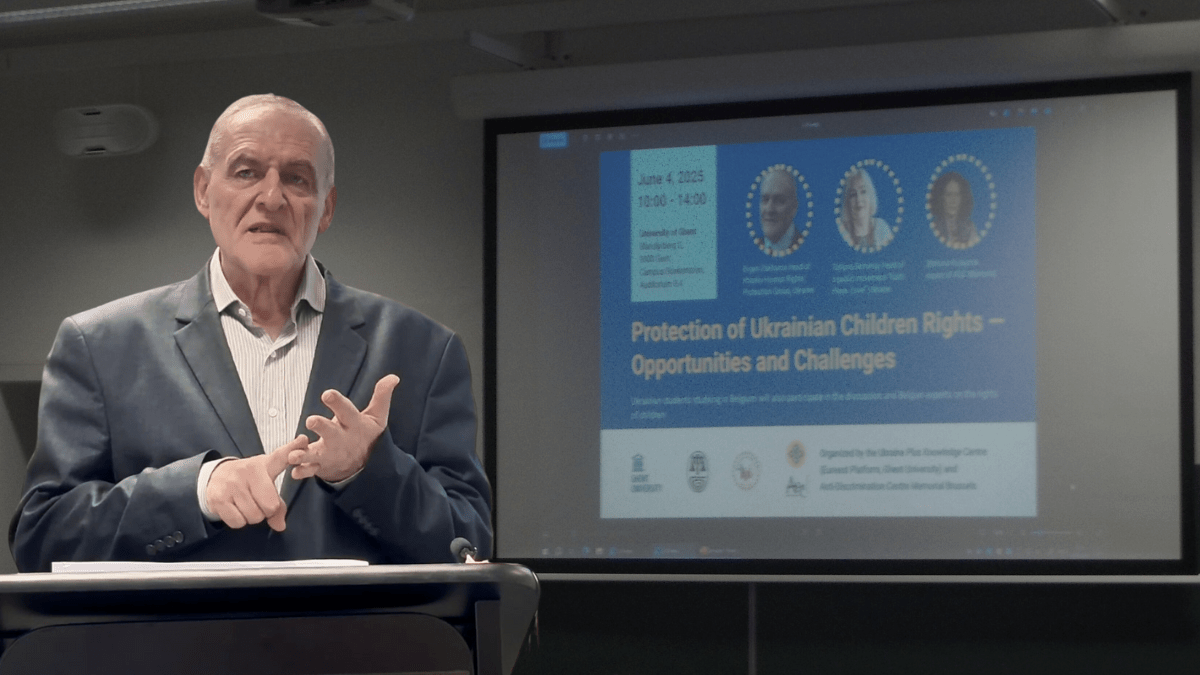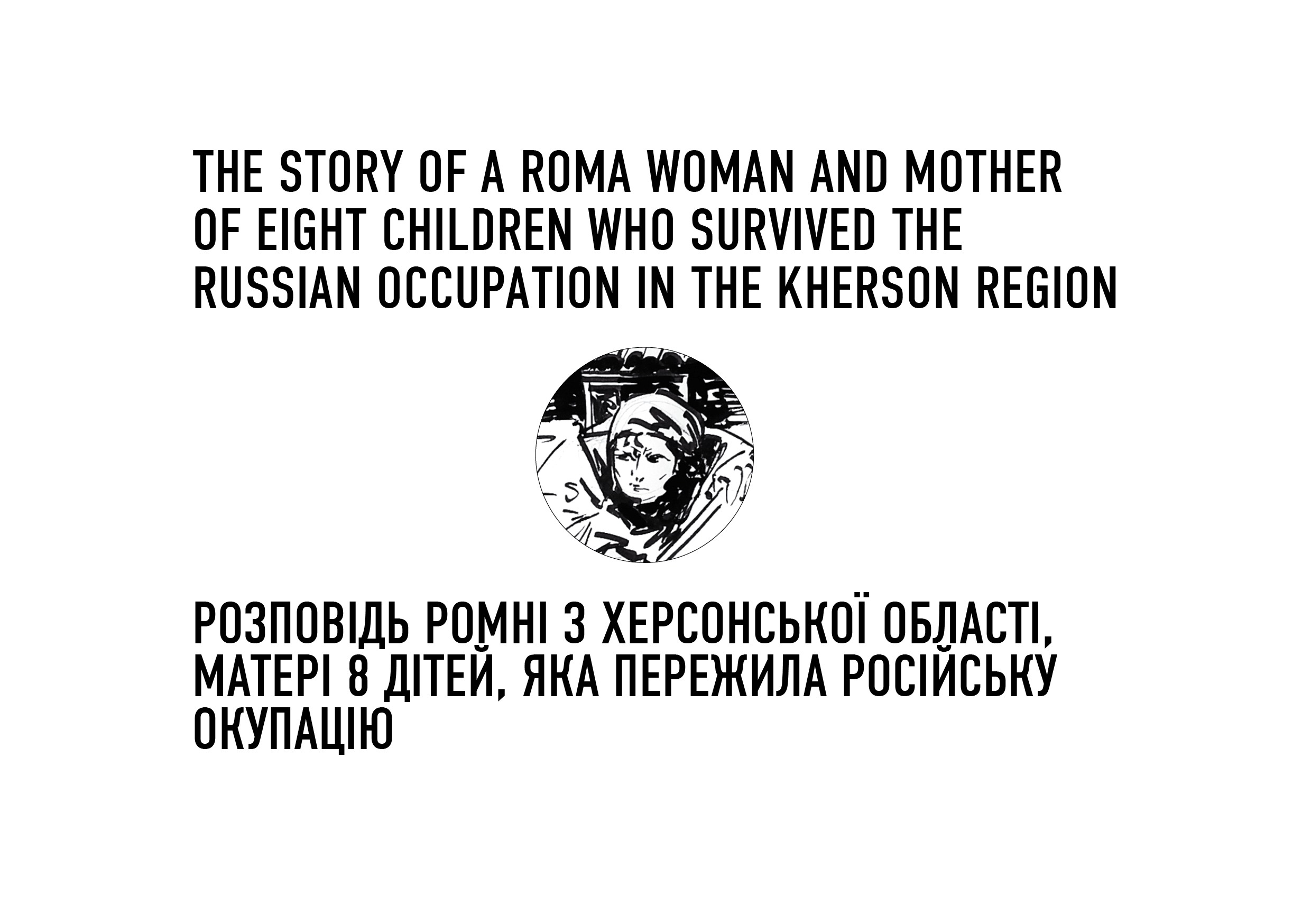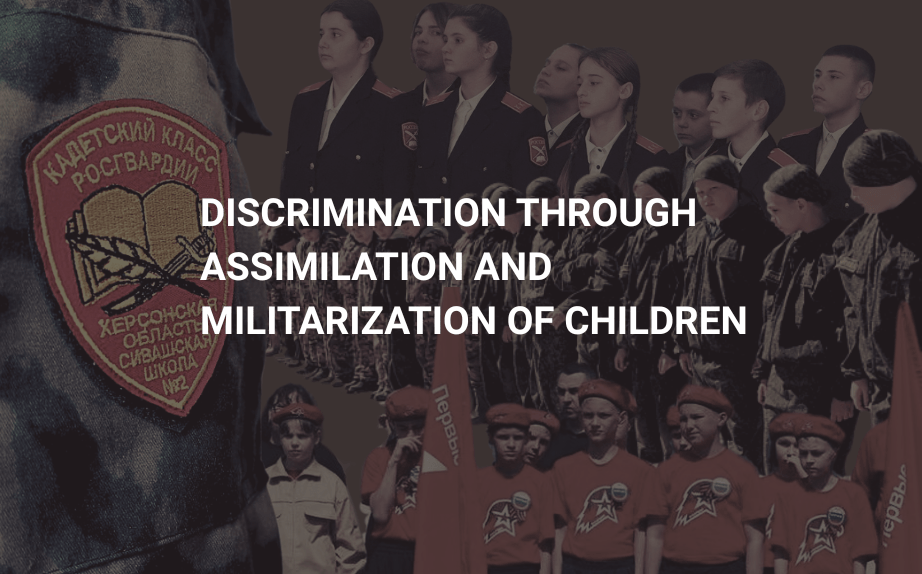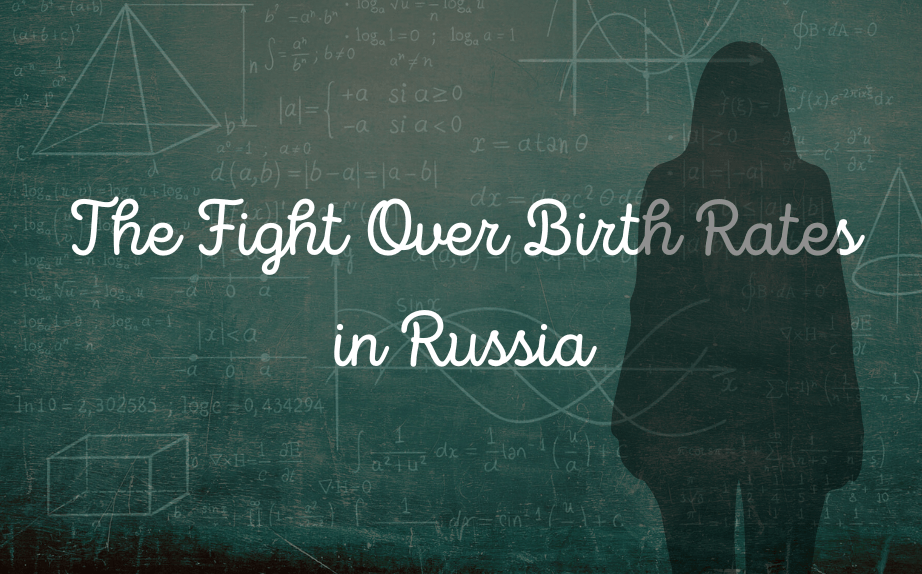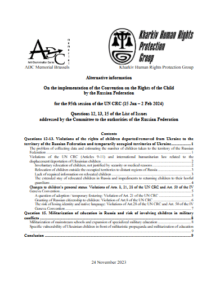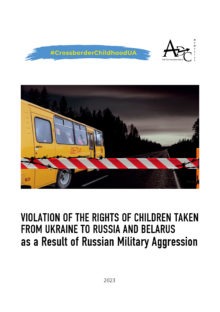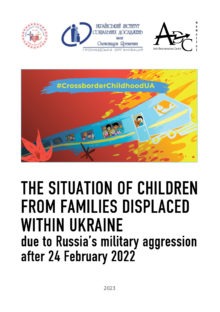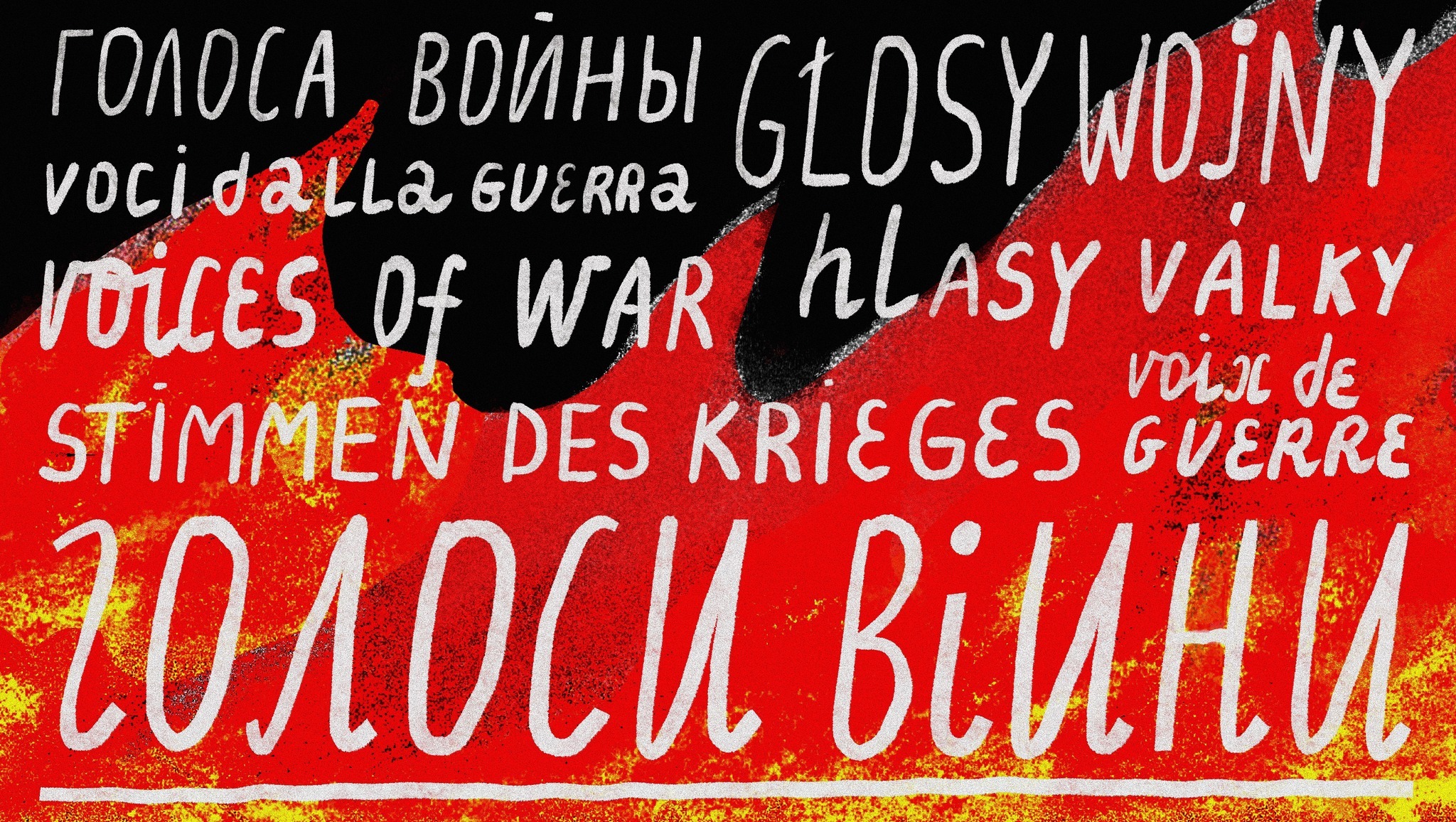The theme of World Refugee Day in 2025 is solidarity with refugees. Children are a particularly vulnerable group in the process of seeking asylum and all kinds of displacement and require special support when returning to the country and reintegrating. ADC Memorial publishes presentations by Ukrainian experts at a conference in Ghent University, where issues of protecting the rights of Ukrainian children, including those abducted, displaced and forced to emigrate, were discussed.
Russia ‘s war crimes against Ukrainian children in perspective of international justice
Yevhen Zakharov, head of the Kharkiv Human Rights Protection Group, a leading expert on the projects “Voices of War” and “Tribunal for Putin” (T4P)
I will talk about the issues of forced displacement of Ukrainian children from Ukraine to Russia. Let me remind you that back in 2014, Russia tried to take orphanages from Donbass to Russia. That time four orphanages were taken out, but the Ukrainian Ombudsman, Valeria Lutkovska, managed to stop this attempt and forced the Russian government to return them back to Ukraine. Another fact that the deportation of Ukrainians from the occupied territories of Ukraine in Donbas began before February 24, 2022. Namely, from February 18 to March 2, 2022, 140,000 residents of these territories were forcibly removed, including 40,000 children among them.
With the outbreak of a full-scale war, a very active policy began to relocate children who were in orphanages in the occupied territory. These are orphaned children or those whose parents were deprived of parental rights, and children who did not have guardians. For this purpose, places where children were accepted were set up in Russia: sanatoriums, children’s camps, orphanages, and so on. There were 67 such places in the Voronezh Region alone. Examples can be also given in other regions close to Ukraine, where children were taken out en masse.
At the same time, it should be noted that all this was in the nature of a broad public campaign, which was very widely covered in the Russian media and in which government officials of the Russian Federation participated. This accelerated especially after the personal meeting of the president of the Russian Federation Vladimir Putin with the Children’s Ombudsman Lvova-Belova on March 9, 2022. This meeting was broadcast on all TV channels in Russia and they attached great importance to it. It was about how to transport children from Ukraine to Russia, what to do with them, what they need to be given to foster families, what are the obstacles for that. Lvova-Belova said that the lack of Russian citizenship is a problem. Putin said: “Submit proposals to the State Duma, we will definitely consider them and take them into account.”
In other words, it all rose to a very high state level, and literally every case of a group of children being taken to Russia was broadcast or filmed, and articles were written for the media. All this was, I would say, very ostentatious. And already at that moment it was said that these children would be given to foster families.
In general, it is possible to describe in such a simplified way the system that was created in Russia for the forced removal of children from Ukraine to Russia:
- The first is the transportation from the occupied territories to Russia.
- The second is the placement of these children in pre–prepared temporary facilities. I have already told you about sanatoriums, orphanages, children’s camps, and so on. There were several dozen of them in each region.
- The third is the simplified granting of citizenship to Ukrainian children.
- The fourth is custody and adoption in Russian foster families.
Actually, it was precisely because all this was done publicly and widely shown, because that regulations were adopted, all this made it possible for the International Criminal Court to open criminal proceedings on the war crime of forced removal of children from Ukraine to Russia on March 13, 2023.
And on March 17, the Second Chamber of the Preliminary Investigation of the International Criminal Court issued arrest warrants for Russian president Putin and Children’s Ombudsman Lvova-Belova. The reason was probable responsibility for a war crime, illegal deportation of children, illegal removal of children from the occupied territory of Ukraine.
The Prosecutor’s Office of the International Criminal Court is investigating this war crime. According to our organization, the Kharkiv Human Rights Protection Group, this should be qualified not as a war crime, but as a crime of genocide; thus, not the 8th article of the Rome Statute, but the 6th article should be applied.
Now I’d like to explain why we think so. We have made a special submission to the International Criminal Court on this issue, and have proved that this is genocide. You can find this submission on our website in Ukrainian and English.
Let me start with two quotes – they are disgusting, but they just give a clear picture of the attitude of senior officials of the Russian Federation towards the Ukrainian state. The first one is a very characteristic statement by Vladislav Surkov, assistant to the President of Russia, from his interview on February 26, 2020, 4 years before the war. Speaking about the possibility of Ukraine’s existence, he said:
“There is no Ukraine. There is Ukrainianism. That is, a specific mental disorder. An obsession with ethnography taken to extreme lengths in a surprising way. Such bloody regional studies. Chaos instead of a state. There is borscht, Bandera, bandura. But there is no nation. There is a brochure called “Samostiina Ukraina” (Independent Ukraine), but there is no Ukraine. The only question is, is Ukraine already gone, or is it not there yet? … Relations with Ukraine have never been simple, even when Ukraine was part of Russia. Ukraine has always been a troublesome matter for the imperial and Soviet bureaucracy. Either Ataman Polubotok will let them down, or the westerners will defect to Hitler. Forcing brotherly relations by force is the only method that has historically proven effective in Ukraine. I don’t think any other method will be invented”.
The Russian president Vladimir Putin wrote an article in July 2021, “On the historical unity of Russians and Ukrainians”:
“Recently, answering a question about Russian—Ukrainian relations during a Presidential Hotline, when answering a question about Russian-Ukrainian relations, I said that Russians and Ukrainians are one people, a single entity. These words are not a tribute to some kind of expediency or current political circumstances. I have spoken about this more than once; it is my conviction. Therefore, I consider it necessary to explain my position in detail and share my assessment of the current situation. … Thus, modern Ukraine is entirely a product of the Soviet era. We know and remember that it was largely created at the expense of historical Russia. It is enough to compare which lands were reunited with the Russian state in the 17th century and which territories the Ukrainian SSR left the Soviet Union with. … Millions of Ukrainian residents rejected the “anti-Russia” project. The people of Crimea and Sevastopol made their historic choice. And the people in the southeast peacefully tried to defend their position. But all of them, including children, were labeled as separatists and terrorists. … We understand all the tricks associated with the “anti-Russia” project. And we will never allow our historical territories and the people who live there, who are dear to us, to be used against Russia. And to those who attempt to do so, I want to say that in this way they will destroy their own country. … Together, we have always been and will always be many times stronger and more successful. After all, we are one people.”
From these quotes, it is obvious that the head of the Russian state is questioning the recognition of Ukraine as an independent, sovereign state. Strictly speaking, the existence of Ukrainian citizens, Ukrainians as a national group, is being questioned.
All this is a complete lie and historical sophistry that tries to justify an attack on Ukraine in the future, as well as the commission of crimes, in particular, genocidal actions against the people of Ukraine aimed at their destruction. Actually, we are talking about the genocide against the Ukrainian national group, which we can define as follows.
Firstly, it is a community of people who have Ukrainian citizenship, have common rights and duties, and have a close legal relationship with the state of Ukraine. This is an objective criterion.
Secondly, it can be pointed out that the national group “Ukrainians” has such characteristics as a European or Western identity. I mean the intention to belong as a nation-state of Ukraine to the Western world, which is opposed to the movement and unification in integration with Russia for the sake of building a union state or other forms of close cooperation. Finally, it should be noted that for more than 30 years of the existence of independent Ukraine, stability of the corresponding national group have appeared. A certain and significant part of this group has already been born in sovereign and independent Ukraine, and has no ties to Ukraine’s Soviet past.
I would like to remind you that genocide is understood as deliberate actions aimed at destroying, in whole or in part, a national, ethnic, racial or religious group as such. Thus, we are talking about the destruction of a person by belonging to a certain group. As we have already found out, in relation to Ukraine, we are talking about the Ukrainian national group. The Convention on Genocide lists five acts of genocide. We are currently considering the fifth act, namely the forced transfer of children from one group to another, from Ukraine to Russia, from the Ukrainian national group to Russia.
The forcible transfer of children from Ukraine to Russia: A Genocide
The Kharkiv human rights protection group argues in the report that by taking children out of Ukraine, the Russians are committing the crime of genocide.
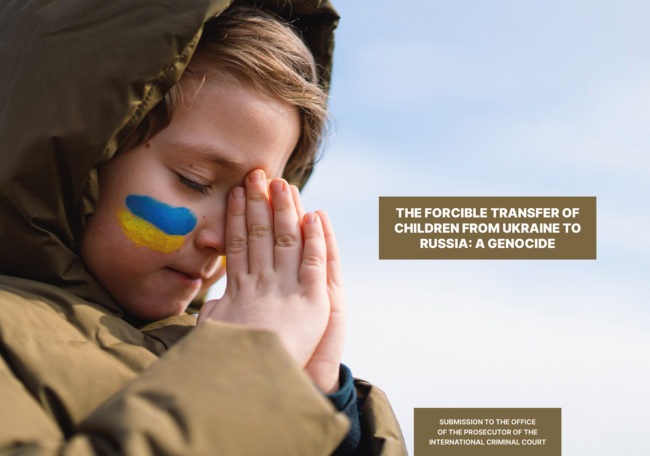
When we say “forced”, it should be understood that this term is not limited to literally physical force. It may include threats of force or coercion, for example, arising from fear of violence, restraint, psychological pressure, or abuse of power against such a person, or by using an environment that creates coercion, as was the case in Mariupol, when families were asked to leave for Russia because otherwise they would have died in basements from Russian bombs.
We can say that the key question is whether the victim was able to make a real choice – to agree or disagree to this deportation or removal. It is obvious and significant that the displacement was involuntary in nature, when the persons concerned had no real choice. In this case, that’s exactly what happened. Due to their age and vulnerable situation, the Ukrainian children displaced to the Russian Federation had no choice but to comply with the procedure. Thus, their displacement should be considered forced for the purposes of the Rome Statute.
At the same time, the displacement operation was carried out openly and publicly by the Russian authorities against the background of a number of steps that could serve as evidence of forced displacement, as recorded in the Rome Statute of the International Criminal Court and in the practice of international ad hoc tribunals.
It is important to prove that this is a crime of genocide, there is an intention for this public deportation. We can say that this fact, the existence of this intent, proves the decree of the President of the Russian Federation, issued on May 30, 2022, under the number 330. In fact, by signing this decree, the President of the Russian Federation officially approved the policy of forced transfer of Ukrainian children to Russia at the highest political level. As I have already said, one of the main obstacles to the transfer of Ukrainian children to foster families was their lack of citizenship of the Russian Federation. When this decree was adopted, this obstacle was formally eliminated.
A few words about which children, which categories of children were taken to Russia
Firstly, these are orphans and children whose parents are deprived of parental rights and who were in orphanages. Those who did not manage to escape – one such orphanage escaped – they managed to leave Ukraine for Europe, before the occupation.
The second group consists of children whose parents died during the fighting, particularly in Mariupol, where there were many civilian casualties. The upper limit is 100,000 dead. Nobody knows the exact figure. And children who were left without parents were taken to hospitals and then taken to Russia.
The third group consisted of children who were separated from their parents during filtration. When the Russians drove a large number of Ukrainians from Mariupol to Russia – that’s 135,000 people, by the way – they were all interrogated about their attitude to the war, to Russia, in order to identify disloyal people to the Russian Federation, those who support Ukraine. Many cases have been recorded when parents were arrested, sent for filtration, and the children were left alone. And after that, they also tried to give them to foster families.
Basically, if the relatives of these children tried to take them back – the grandparents – they searched for and found them in Russia, followed them and took them away, then they were given back, albeit with difficulties. I am not aware of cases when such children were not given back to relatives. They were persuaded that they would be better off in Russia, but in the end they gave it back. Those children who went through the filtration process, if their parents managed to come and pick them up on time, were also picked up.
As for orphans and those who do not have guardians, it is very difficult to return them back. In general, the number of such children, who are very difficult to return, who were transported like this, who do not have relatives to pick them up, is about 2 thousand. When somebody talks about a much larger number, they mean that all the children who came to Russia, even with their families and parents, were strongly influenced by indoctrination and re-education in the Russian ideology, thus they would forget that they are Ukrainians. And the younger the child, the easier it could be done.
I can tell you much more about different specific cases, groups of children, and children who have been imprisoned in Russia – there have been several hundred such cases. But I have to stop at this point and thank you for your attention.
Children of Ukraine and the war
Tetiana Semikop, head of the public movement “Faith. Hope. Love” (Odesa)
Children under occupation
As of May 2025, a significant number of children live in the temporarily occupied territories of Ukraine, facing numerous violations of their rights. According to Ukrainian and international human rights organizations, children in occupation face the following main problems:
- Forced Russification of education: Russian educational programs are being introduced in the occupied territories, resulting in changes in curricula, textbooks, and the language of instruction. Teaching of the Ukrainian language and literature is prohibited or minimized.
- Indoctrination: children are involved in activities aimed at forming pro-Russian views, including participation in propaganda campaigns and events.
- Restriction of freedom of movement: children and their families face difficulties when trying to leave the occupied territories, in particular due to complicated procedures and risks at checkpoints.
- Psychological pressure: children are under constant stress due to military operations, restrictions on freedom and uncertainty of the future.
The exact number of children in the occupied territories varies depending on the sources, but it is estimated that there are hundreds of thousands of people. The Ukrainian authorities and international organizations continue to make efforts to monitor the situation and provide assistance to these children.
Children and education during the war
The war in Ukraine has significantly affected the education system, especially for children living in war zones or temporarily occupied territories.
Damage and destruction of educational infrastructure
As of the end of 2024, according to the Ministry of Education and Science of Ukraine, more than 3,500 educational institutions have been damaged or destroyed. This includes schools, kindergartens, and other educational institutions. In particular, 347 institutions were completely destroyed as a result of shelling and bombing. (Ombudsman of Ukraine)
Education in the temporarily occupied territories
In the temporarily occupied territories, the Russian Federation is implementing its own educational system, in particular:
- The replacement of Ukrainian curricula with Russian ones: the teaching of history, literature and other subjects is based on Russian standards that distort facts and impose a pro-Russian ideology. The Ukrainian language is excluded from the educational process, which violates the right of children to education in their native language.
- Forced provision of Russian documents: children are forced to obtain Russian birth certificates and other documents, which makes it difficult for them to return to the Ukrainian educational system.
- Indoctrination: the introduction of “cadet classes” and military training lessons from the age of 6 is aimed at militarizing the consciousness of children. (Ombudsman of Ukraine)
Distance learning and its challenges
Due to the danger to the life and health of children, many schools have switched to distance learning, which has raised a number of problems:
- Lack of technical facilities: not all students have access to computers or a stable Internet connection.
- Psychological pressure: for children, being in war conditions negatively affects their concentration and motivation to study.
- Lack of stability: frequent relocation and change of residence make it difficult to study and adapt to new schools.
International support and initiatives
International organizations such as UNICEF and the United Nations provide support to Ukraine in ensuring the continuity of education in the following aspects:
- Supply of educational materials and equipment: providing schools with the necessary resources for distance learning.
- Psychological support: organization of trainings and consultations for teachers and students in order to overcome stress and trauma.
- Reconstruction of damaged schools: restoration of educational infrastructure in de-occupied regions.
Thus, the war in Ukraine has created unprecedented challenges for the education system, especially for children living in conflict zones. Ensuring access to quality education in wartime conditions is a priority for the Ukrainian government and the international community.
Medicine and children’s health during the war
The aggression of the Russian Federation against Ukraine has caused a large-scale humanitarian crisis, which has significantly affected the healthcare system, especially the medical care of children.
Destruction of medical facilities
According to the Ministry of Health of Ukraine, as of May 2025, more than 1,000 medical institutions have been damaged or destroyed as a result of shelling and fighting, including:
Maternity hospitals: About 50% of maternity hospitals in active combat zones have been damaged or completely destroyed. Children’s clinics and hospitals: A significant number of children’s health facilities were destroyed or damaged, making it difficult for children to access medical care.
Limited access to medical care
In war zones and temporarily occupied territories, children face limited access to medical care, as there is a shortage of medical personnel (many medical workers were forced to evacuate or became victims of the fighting). Insufficient supply of medicines: disruptions in the supply of medicines and medical equipment make it difficult to treat children, especially those with chronic illnesses. Disruption of logistics chains: the destruction of infrastructure has hampered the delivery of humanitarian aid and medical resources.
Psychological health of children
War has a profound effect on the psychological state of children:
- Post-traumatic stress disorder (PTSD): Many children have experienced traumatic events such as the loss of loved ones, the destruction of homes, which leads to the development of PTSD.
- Depression and anxiety disorders: instability, fear and uncertainty of the future cause the development of depressive and anxious states in children.
- Sleep disorders and behavioral disorders: Frequent shelling and evacuations negatively affect children’s sleep and behavior.
International support and initiatives
International organizations provide support to Ukraine in the field of children’s healthcare:
- UNICEF: provides medicines, vaccines and medical equipment, and organizes mobile clinics to provide medical care to children in remote areas.
- WHO: provides technical support and training for health workers to help children in crisis situations.
- The International Red Cross: organizes evacuation of wounded children and provides humanitarian assistance in conflict zones.
Thus, the war in Ukraine has created serious challenges for the healthcare system, especially in terms of providing medical care to children. Ensuring access to quality medical care and psychological support is critically important for maintaining the health and well-being of Ukrainian children.
Children in Europe: emigration and adaptation
Since the beginning of the full-scale invasion of Ukraine by the Russian Federation in February 2022, millions of Ukrainian citizens have been forced to leave their homes, seeking safety abroad. A significant part of them were children, both accompanied by their parents and pupils of boarding schools.
Evacuation of children from institutions
In the early days of the war, more than 38,000 of the 48,000 children in institutional care were evacuated from Ukraine. They were placed in safer regions of the country or abroad, mainly in the countries of the European Union. The evacuation was carried out in order to ensure the safety and proper care of children in a military conflict. UNICEF
Children who left Ukraine with their parents
The exact number of children who left Ukraine with their parents remains unknown. This is due to the lack of centralized statistics and the difficulty of data collection in the context of mass migration. However, according to experts, we are talking about hundreds of thousands of children who have found temporary asylum in European countries. Many of them were forced to adapt to the new conditions of life, education and social environment.
Problems of adaptation
Children who have gone abroad face a number of challenges:
- Language barrier: the need to learn a new language for schooling and communication.
- Educational systems: differences in curricula and approaches to education.
- Psychological stress: war trauma, separation from family, and adaptation to a new environment.
Nevertheless, many children successfully integrate into new communities, make friends and continue to study. For example, one of the mothers who went to Poland with her six-year-old daughter notes that the child quickly adapted to Polish school and found new friends.
Support from host countries
The countries of the European Union provide various support to Ukrainian refugees, in particular:
- Social benefits: financial assistance for families with children.
- Educational programs: the opportunity to study at local schools and participate in additional courses.
- Psychological support: counseling and therapy for children who have experienced traumatic events. These measures are aimed at providing appropriate conditions for the life and development of Ukrainian children abroad.
Illegal removal of Ukrainian children to Russia
Since the beginning of the full-scale invasion of Ukraine by the Russian Federation in 2022, numerous cases of illegal removal of Ukrainian children to the territory of Russia and the regions temporarily occupied by it have been recorded. These actions violate international humanitarian law and may qualify as war crimes.
The scale of the deportation
Official data: As of February 2025, according to Oksana Zholnovych, Minister of Social Policy of Ukraine, Russia has deported or illegally displaced almost 20,000 Ukrainian children. Of these, 1,223 children were returned.
Statements by Russian officials: In July 2023, Maria Lvova-Belova, the Presidential Ombudsperson for Children’s Rights, stated that Russia had “accepted” more than 700,000 Ukrainian children, of whom about 1,500 were children from orphanages or left without care.
Removal mechanisms
The Russian Federation uses various mechanisms for the removal of Ukrainian children:
- Under the pretext of “rehabilitation”: children from temporarily occupied territories are taken to camps in Russia and the occupied territories of Ukraine under the pretext of wellness programs. For example, in 2025, it is planned to export 53,000 children for “summer holidays” in camps such as Artek (occupied Crimea), Orlyonok (Krasnodar Territory) and others.
- “Re-education” programs: Children undergo indoctrination programs, including academic education, military training, and military-patriotic education.
- Adoption by Russian families: Some children, especially those who were left without parental care, were adopted by Russian families, which violates international law.
International reaction
- Arrest warrants: The International Criminal Court has issued arrest warrants for Russian President Vladimir Putin and OMbudsperson for Children’s Rights Maria Lvova-Belova for the illegal deportation of Ukrainian children.
- Recognition of the genocide: On April 27, 2023, the Parliamentary Assembly of the Council of Europe recognized the deportation and forced transfer of Ukrainian children to the territory of Russia as genocide.
The return of children
Ukraine is actively working on the return of illegally exported children:
- Charitable organizations: Save Ukraine promotes the repatriation and family reunification of abducted Ukrainian children.
- Government initiatives: mechanisms have been developed for the reintegration of children who return to their families or find a new family through adoption or foster care.
Children who have been left without parental care and are in foster care
The war in Ukraine has led to numerous cases of children losing parental care due to the death or injury of parents, as well as due to the divorce of families. This has created the need of alternative forms of education and care for such children.
Statistics and the scale of the problem
Number of children left without parental care: as of 2024, according to the Ministry of Social Policy of Ukraine, more than 100,000 children have lost one or both parents as a result of hostilities. Foster families: Most of these children were placed in foster homes, family-type orphanages, and other forms of alternative parenting.
Problems of children who have lost one or both parents
- Psychological trauma: Children who have experienced the loss of their parents often suffer from post-traumatic stress disorder (PTSD), depression, and other psychological problems.
- Adaptation to new conditions: The transition to a new family or institution can be difficult for children, especially if they were previously in boarding schools or were evacuated from temporarily occupied territories.
- Lack of resources: Lack of funding and resources in foster homes makes it difficult to provide adequate care and development for children.
International support
- UNICEF: provides psychological support to children and families, conducts trainings for foster parents and social workers.
- Red Cross: organizes humanitarian aid and provides basic needs for children left without parental care.
- NGOs and charities: Provide additional support, including educational materials, clothing, medical care, and other resources.
Thus, although the foster care system in Ukraine provides for the basic needs of children left without parental care, there is a need for additional support and resources to ensure their full development and adaptation to new living conditions.
Children and sexualized violence during the war
According to the Prosecutor General’s Office of Ukraine (as of May 2025), more than 1,200 criminal proceedings related to the sexualized abuse of children in the war zone have been registered since the beginning of the full-scale invasion of Russia (February 2022). This figure reflects the lower threshold of the problem, as many cases are not documented due to the stigma and risks of personal safety. UNICEF estimates that the actual number of children affected by sexualized violence may be 3-4 times higher. The largest number of cases was recorded in the temporarily occupied territories of Donetsk, Luhansk, partially Kherson and Zaporizhia regions, where there is no effective access for human rights defenders and doctors.
Known cases
- According to the Ukrainian investigative authorities, confirmed cases of violence include rape of children aged 6 to 16 years, some cases involving torture.
- Among the victims are children from displaced families, children from families remaining in the occupation zone.
- There are reported facts of abductions of children by the occupiers for sexual exploitation and forced removal to Russia.
Government reaction
- In 2023, special units in law enforcement agencies were created in Ukraine to investigate crimes related to sexualized violence, in particular, separate investigative groups, which include psychologists and specialists in countering violence.
- Hotlines and a network of crisis centers have been introduced where children and their loved ones can receive anonymous help.
Assistance from international organizations
UNICEF, together with partners, conducts trainings for local specialists on the identification of cases of sexualized violence and the provision of primary care. The UN and international NGOs provide psychological and legal support to victims.
Injured and dead children
According to expert estimates, the number of dead children since the beginning of the full-scale war (February 2022) exceeds 3,500 people. This number includes deaths directly during hostilities, as well as as a result of mine explosions, shelling, and airstrikes (deaths of children in hospitals and maternity hospitals as a result of shelling and blackouts, and the inability to provide emergency medical care). More than 7,200 injured children were registered during the same period. Many of them received severe injuries — amputations, wounds to internal organs, burns. The largest number of casualties was recorded in areas heavily affected by the fighting: Donetsk, Lugansk, Kharkov, Zaporizhia, Kherson regions.
Characteristics of wounds and their consequences
These are often injuries caused by explosions of mines, shells, airstrikes, and shelling, which leads to severe disability. Medical institutions during the war have limited opportunities for the rehabilitation of children, which makes it difficult for them to recover and return to a full life.
Medical care and rehabilitation
- With the support of international organizations (the United Nations, UNICEF, the Red Cross), mobile medical teams, trauma and rehabilitation centers for children have been established in Ukraine.
- Telemedicine projects play an important role, allowing specialists from abroad to be involved in diagnosis and treatment.
Laws of Ukraine on war children: categories and support measures
Ukraine has adopted a number of laws and regulations governing the rights and protection of war-affected children, in particular:
- The Law of Ukraine “On Children of War” (approved by the Verkhovna Rada in 2024, updated in 2025) is the main document that defines the status and social protection of children affected by the Russian-Ukrainian war.
- Amendments to the laws “On Child Protection”, “On social protection of persons affected by military operations”, as well as laws regulating the issues of internally displaced persons (IDPs).
Who are recognized as children of war?
The Law defines several categories of children eligible for special State support:
- Children who have lived or been in the combat zone since 2014 (the beginning of the war in Donbas) and especially since February 24, 2022 (full-scale invasion).
- Children who were evacuated from the territories where active hostilities were taking place, as well as children of internally displaced persons.
- Children who lost one or both parents as a result of the war.
- Children who suffered from mine-explosion injuries, wounds, physical or sexualized violence in connection with the war.
- Children displaced or abducted to Russia who have returned or are in the process of returning.
The main types of support
- Financial assistance: targeted government payments, social pensions, one-time compensation for affected families and children.
- Educational support: free access to education, including distance education, provision of scholarships and textbooks, creation of special reintegration programs.
- Psychological and medical care: access to rehabilitation services, crisis centers, support for families with children with mental injuries.
- Legal support: assistance in paperwork, protection of children’s rights, support in cases related to the restoration of lost housing or property.
- Integration programs: support for children from boarding schools and foster families, creation of safe spaces, opportunities for the development of creative and athletic abilities.
Examples of support implementation
- In 2024, a network of state and public centers for helping war children was established in most regions of Ukraine.
- The Ministry of Social Policy of Ukraine, together with international partners (the United Nations, UNICEF), implements programs for the social adaptation and rehabilitation of children.
- Legislative initiatives have been introduced to accelerate the return of children abducted or taken to Russia.
Children who went missing and are wanted during the Russian-Ukrainian war
According to the Ministry of Internal Affairs of Ukraine and the Prosecutor General’s Office, as of May 2025, more than 2,700 children have been missing since the beginning of the full-scale invasion of Russia in February 2022. Of this number, about 1,500 children are on the active wanted list, the rest are cases in which investigative actions are ongoing. The largest number of missing children are in the occupied territories of Donetsk, Luhansk, Kherson and partly Zaporizhia regions, where active hostilities were taking place, as well as in places where mass deportations and abductions took place.
The main reasons for the disappearance of children
- Military actions, shelling, destruction of houses, leading to loss of contact with relatives.
- Mass evacuations, separation of families during displacement.
- Abduction of children, in particular forcible transportation to Russia or the occupied territories.
- Escape or conceal children from dangerous areas.
Search and return measures
- Ukraine has a Coordination Center for the Search for Missing Children, which includes representatives of law enforcement agencies, the Security Service of Ukraine, the Ministry of Social Policy, as well as international organizations such as UNICEF and the International Committee of the Red Cross.
- A unified electronic database of missing children has been created with open access for the public and relatives.
- Psychological support programs are actively used for families waiting to their children to be found.
- Special attention is paid to coordination with international structures for the search and return of children abducted or taken to the Russian Federation.
Examples
Over the period 2023-2025, more than 350 children have already been returned to Ukraine thanks to the joint efforts of government agencies and international partners. There are ongoing campaigns to inform the public about child search mechanisms, hotlines, and mobile applications for reporting missing persons.









 Feedback
Feedback 